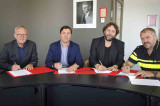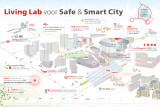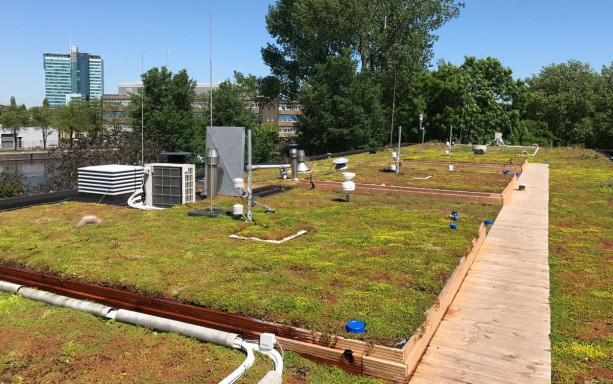Stay in the know on all smart updates of your favorite topics.
Pientere Tuinen

Pientere Tuinen is een 3-jarig project dat begin april 2023 is gestart. Tot eind 2023 kunnen nieuwe deelnemers aansluiten bij het grootste participatieproject in Nederland. Pientere Tuinen is een samenwerking van 7 publieke en private partijen.
De aanpak in Pientere Tuinen draait om drie samenhangende onderdelen.
1. Data verzamelen met een slimme sensor en een interactief/educatief dashboard van de eigen tuin voor de individuele inwoner,
2. Kwantitatief (data-analyse) en kwalitatief (interviews/surveys) onderzoek naar strategieën voor een gezonde leefomgeving en duurzame gedragsverandering,
3. Advies op maat aan bewoners over de inrichting en het beheer van de tuin
Het doel van Pientere Tuinen is een groenere, gezondere leefomgeving te creëren door het bewustzijn en de motivatie bij tuinbezitters te vergroten. Dat doen we door data te verzamelen, onderzoek uit te voeren en meer maatwerk te bieden in de advisering en voorlichting aan bewoners.
Enkele voordelen van uw deelname aan Pientere Tuinen op een rijtje
- Tuinbezitters krijgen een bodemsensor die drie jaar lang hitte, bodemkwaliteit en het vochtgehalte meet, waarvan resultaten zichtbaar zijn op een dashboard
- Tuinbezitters krijgen (mede op basis van de data) specifieke voorlichting voor het vergroenen van de tuin door middel van tuintips, stappenplan en mogelijke (wijk)workshops
- Deelnemende organisaties zijn onderdeel van het grootste participatieproject van Nederland met ca. 5.000 deelnemers en meetpunten door heel Nederland
- Deelnemende organisaties worden betrokken bij twee langdurige, landelijke onderzoeksprogramma’s naar motivatie voor vergroening en gedragseffecten van verschillende interventiestrategieën, en data-analyses van milieu- en gezondheidsaspecten
- Als organisatie bent je zelf als partner zichtbaar in een landelijke PR- en communicatiecampagne rondom het project.
- Je leert zelf binnen de community over structurele, duurzame vergroening met uw inwoners onder andere van de onderzoeksprogramma’s en andere projectpartners
Responsible smart doorbells

Photo: Daan Rozinga, The Incredible Machine
The Responsible Sensing Lab is currently working on a few projects regarding smart doorbells.
Smart doorbells are like a security camera's, but available for everyone. Always on, and owned by private parties, the smart doorbell is destined to have an impact on our privacy. As of now, there could be thousands of smart doorbells in Amsterdam, filming public space. We don t have a clear view on the numbers, and we do not know what the owners do with the collected data. Smart doorbell owners are often not aware of the privacy issues.
One of the Responsible Sensing Lab's projects is Shutterring. The Shutterring project aims to make smart doorbells more responsible by ensuring the privacy of bypassers and owners while keeping the main functionality of the device intact. Shutterring is a design by The Incredible Machine.
Inspired by Shutterring, the Lab has started another project regarding responsible smart doorbells: Challenging the design of smart doorbells. In order to challenge the current design of smart doorbells (IoT doorbells with integrated cameras) a few alternative smart doorbells have been created through speculative design. The goal of this project is to kickstart a conversation about how to deal with the presence of smart doorbells in the city of Amsterdam. How could smart doorbells be designed in a way that they align better with the values of the city and its population?
The Responsible Sensing Lab team will present both their smart doorbell projects during the demo day on 11 October. Stay tuned!
Simple Sensors for responsible sensing

City officials require sensor data to optimize operations, plan projects, or measure effects of interventions. Citizens often do not notice the sensors deployed by the City in public space. Also, the benefit for the public is not directly obvious to city residents or immediately shown by the sensing systems in place. Namely, in many cases only after data is processed, it informs an action that affects citizens.
Public concerns about sensors are often connected to concerns about potential action (to be taken by, for example, city officials), and that the action has negative implications. With ‘Simple Sensors’ we address these concerns.
The Simple Sensors project, which is part of the Responsible Sensing Lab, investigates these questions: What if sensors are designed to be seen? What if they communicate clearly what data they collect and how? And what if sensors invite you to interact with them?
Modules for responsible and ‘simple sensing’
Simple Sensors consists of a family of modules, designed by The Incredible Machine, that can be combined: some modules improve transparency over what data is being collected, other modules encourage interaction, and some modules just make it understandable how sensors work. The Simple Sensors family allows the City of Amsterdam to design sensors to fit any context or purpose.
A privacy friendly alternative for CCTV
The first Simple Sensor prototype called millimeter wave (mmWave) has been developed as a proposal for the City’s crowd management sensor at the Marineterrein Amsterdam Living Lab. It consists of four modules: 1) sensor module 2) transmission module, 3) data module, 4) threshold module... Continue reading about the project on our website >>
Shuttercams for a responsible smart city

Shuttercam is a project by Responsible Sensing Lab (RSL), a collaboration between the City of Amsterdam and AMS Institute. In essence, RSL is a testbed for conducting research and experiments on how smart sensing technologies in public space – like cameras – can be designed in a way that makes the digital city 'responsible’.
At the Lab we invite academics and practitioners responsible for digital systems in the city to explore how to integrate social values such as autonomy, privacy and transparency in the design of these sensing systems in public space.
How to know when a camera ‘sees’ you?
The Shuttercam project originated based on the notion that citizens currently can not directly know or see if and when cameras in public space are monitoring you or not. The project also questions the necessity for many non-security related cameras in the city to be switched on indefinitely.
Experimenting with 3 prototypes at Marineterrein
The Shuttercam project will test 3 prototypes. These are installed at Marineterrein Amsterdam Living Lab (MALL) in the upcoming weeks.
First and foremost, the cameras within this project are all part of the crowd monitoring system by the City of Amsterdam, which is a privacy friendly system. So what do these cameras record or see for example?
A crowd monitoring system works with a camera that has an algorithm read out and analyzes video images. In addition to measuring crowds and displaying those crowds in usable numbers, the algorithm can also determine whether people keep a distance of 1.5 meters. All this is done in an anonymous manner that naturally complies with all privacy legislation.
The video images are not watched by a human but are processed automatically. Only a few frames are saved with unrecognizable, blurred people's faces. Those frames help to "train" the algorithm. Furthermore, the images are not saved. Continue reading about the the Shuttercam project >>
Responsible Sensing Lab

Smart city systems can help solve urban challenges. But when collecting data, what public values are involved? The Responsible Sensing Lab explores how to integrate social values such as autonomy, privacy, transparency, inclusiveness and empowerment in the design of sensing systems in public space.
In January 2021 the Responsible Sensing Lab was officially launched during an interactive livestream event. In essence the Lab is a testbed for conducting rigorous, transparent, and replicable research on how our smart technologies placed in public space can be designed in a way that makes the smart city ‘responsible’. Responsible Sensing Lab is a collaboration between the City of Amsterdam and AMS Institute.
A lab for a ‘responsible’ smart city
The City of Amsterdam has many smart technologies in place: from smart devices that measure things (i.e. sensors) to smart devices that steer processes in the city (i.e. actuators) such as traffic lights, charging stations, adaptable street lights, barriers that go up and down, and adaptive digital signs.
At the Responsible Sensing Lab we research, develop and integrate smart technologies like the aforementioned to help solve urban challenges. At the same time, we explore how to embed society’s public and democratic values in the design of these innovations.
(Re)designing, prototype testing and implementing responsible sensing systems
Within the Lab academics are invited to connect and work with practitioners who are responsible for digital systems in the city to (re)design, prototype and test (more) responsible ways of sensing in public space.
Hence, Responsible Sensing Lab is a place where teams of multi-disciplinary stakeholders – such as computer scientists, policy makers, psychologists, designers and hardware experts – can address existing hardware, software and other city sensing systems.
Core values
At the Responsible Sensing Lab, we use the City’s values (TADA, Digital City Agenda) as our starting point. We explore what these values mean when applied to actual software, hardware, user-experience design and governance.
Also, we are inspired by the methodology of value sensitive design. This approach allows us to focus on design choices inherent in the type of sensing hardware, the distribution of intelligence between cloud and back-end, the physical design and placement of sensors in public space, and interaction possibilities for citizens.
Do you want to know more or are you looking to collaborate? Contact us via our website!
Wicked Problems

Te wicked? Niet voor ons.
Wij werken allemaal aan urgente, complexe, maatschappelijke uitdagingen. Issues die schier onoplosbaar lijken, van dilemma’s en paradoxen omgeven, nog niet duidelijk hoe het moet. Wel is duidelijk dát het moet, dat we elkaar nodig
hebben en dat we er NU aan moeten beginnen. Om met de woorden van Jan Rotmans te spreken; we leven niet in een tijdperk van verandering maar in een verandering van tijdperk. En hier hoort een nieuwe gereedschapskist bij.
En of je nou aan energietransitie werkt, andere mobiliteitssystemen, creëren van waterstofhubs, peer to peer autodeelsystemen, het maakt niet uit, we zien dat al deze opgaven op enig moment tegen gelijksoortige barrières aanlopen. Op samenwerking, financiering, privacy, onvoldoende aansluiting op de maatschappij, om maar een paar voorbeelden te noemen.
Unieke samenwerking
Als Amsterdam Smart City netwerk willen en kunnen we deze opgaven niet laten liggen. Door het bundelen van onze kennis en expertise kunnen we als netwerk iets unieks bieden en de wil en durf tonen om deze barrières te doorbreken. De betrokken partners die dit uitdenken en begeleiden zijn RHDHV, Kennisland, Drift, NEMO, Arcadis, Alliander, HvA en Metabolic. Zij bundelen hun expertise en ervaring om de echte vragen boven tafel te krijgen, tot nieuwe manieren van samenwerken te komen en barrières te doorbreken. We richten ons met name op de start van de samenwerking. Gezamenlijk ontwikkelen we een ‘wicked problem aanpak’. Op een nieuwe manier, lerend door te doen, exploratief.
Waar moet je aan denken?
Wat is eigenlijk het echte probleem? Wiens probleem is dit? Hoe kijken anderen er tegenaan? Welke andere partijen lijken nodig? Hoe vind je ze? Hoe ga je om met eigenaarschap en botsende frames? Hoe zorg je dat je al in
een vroeg stadium de maatschappij (bewoners, ondernemers, werknemers, etc) betrekt en hun ervaringen in het project trekt? Het wicked problem team zet nieuwe methoden in voor het beantwoorden van deze vragen. En het creëren van de benodigde commitment om het vraagstuk aan te pakken. Niets staat van te voren vast, want we passen ons aan aan wat we tegenkomen. Met elkaar ontwikkelen we een nieuwe aanpak om de barrières te doorbreken.
Blue Force Tracking

Testing medical certified body sensors to detect unexpected behaviour, triggering an alert, which allows the command & control room to act and better support their fellow officers in the field.
[►
Blue Force Tracking - Nalta Experience #1
How to improve the protection and safety of the Dutch Blue Force using smart Technology?
Nalta built a new innovative Internet of Things solution solving just that. In partnership with the Netherlands Police, the municipality of Amsterdam, Johan Cruijff Arena, Dell Technologies and Dell Boomi we cre
Nalta YouTube](https://www.youtube.com/watch?v=_cyFp_XGLFA)
Conscious Cities

How might we automate access to a public digital ecosystem for citizens and machines in order to grow a conscious city? How might we incentivize all citizens and companies to interact with the public digital ecosystem of the city in order to improve livability, democratic representation and societal engagement?
Read our ecosystem document
Join our online ecosystem platform
Digital Perimeter

By implementing innovative smart & digital solutions, the digital perimeter allows us to experiment with applications that deliver safety & security while providing the visitor with an even better fan experience.
Please do share your comments and thoughts with us as we are currently exploring our technical options with partners within the eco-system.
5G

5G will be the new generation of mobile connectivity. The connection will be faster and more reliable, and will bring previously unknown possibilities for citizens and business. Amsterdam is exploring the opportunities and obstacles on the road to a safe and useful 5G network. One of the ways we do this is with our field lab in Amsterdam South East, from the train station to the Johan Cruijff ArenA. But also through regional, national and international collaborations.
Pavnext - technological pavements

Pavnext´s solution consists of a road pavement equipment that allows kinetic energy to be extracted from vehicles and consequently reduce their motion speed without any action of the driver and without impacting the vehicle, thus promoting road safety at locations where it is required to circulate at low speed. The energy captured is then converted into electrical energy, which is produced without associated emissions and can be used in public street lighting, crosswalks, sensors, traffic lights, charging electric bicycles or even injected into the power grid. Additionally, Pavnext also provides real-time data regarding traffic and velocity, as well as generated and consumed energy, which are sent to the cloud and later used to generate reports and to optimize energy consumption in real time, promoting energy efficiency.
We are looking for new international partners that are interested in implementing pilot plants with us, to help us validate our product and reach TRL9. Please don´t hesitate to contact us if you´re interested.
Amsterdam Open Beacon Network

The City of Amsterdam is exploring the opportunities of a city wide, open beacon network. Currently 200 beacons are installed on almost all bus- and tram stops in the innercity. This is a first step. At this current stage, we want to involve app developers in the use case exploration for such a network.
We would like to invite you to test the open beacon network, and find out what kind of opportunities arise for your business.
Join the Google Group <https://groups.google.com/forum/#!forum/amsterdam-open-beacon-network> to get instant access to the Amsterdam Open Beacon Network and start using the beacons by adding your attachments in your own namespace.
LoRa Smart Lighting + Lightwell

The Marineterrein was keen on developing a living lab for new technology and smart city use-cases. Lightwell helped to realize this ambition by combining its Friso Kramer public lighting fixtures with the most promising Smart Lighting technology available: LoRa.
The LoRa technology is a point-to-point internet of things communication system that uses the free available 868mhz frequency. At the Marineterrein Lightwell and technology partner Ziut decided to use a private (non telecom) network to secure its open-source character but also to guarantee the lifespan of the system. This is interesting for large metropolitan area's if they have smart city ambitions because the availably of the network is more secure if the City runs its own network and isn't solely dependent on a network-provider like a telecom-company. LoRa technology is therefore a future-proof system to which al kinds of features (censoring, lighting etc.) can be added.
The whole system set-up is on show at the Marineterrein. The 42 fixture can't be missed because of the beauty of the design by Friso Kramer.
During the We Make the City event 20-24 June 2018 tours will be held to explain the system functionalities.
Project Smart Roof 2.0

Project SmartRoof 2.0 is an innovative, lightweight, blue-green roof, that has been installed on Building 002 at the Marineterrein Amsterdam. Water management (blue) and plants (green) are carefully monitored using sensors. This provides a wealth of information.
Water is essential for plant growth. That’s why the blue-green roof features an 85 mm-high Permavoid hollow drainage layer that stores rainwater directly under the planted layer. These Permavoid units have special fibre cylinders that use the capillary effect to provide the plants with water during dry spells. This creates natural irrigation without using pumps, hoses, or energy: just like in nature.
About Marineterrein Amsterdam:
At Marineterrein Amsterdam, solutions to global issues are devised, tested and put into practice. Here, a leading international community of innovators, scientists and businesses work together toboost and build upon the strong international position held by both Amsterdam and the Netherlands. The Marineterrein is going to be a future-proof city district featuring open innovation, accessible and flexible living and working space, unique housing, sports, recreation, and greenery.
Current sensors:
Sensortype Aantal
Regenmeter 1
Infraroodcamera 1
oppervlaktetemperatuur 2
Bodemvocht 14
Bodemtemperatuur 14
Waterhoogtemeter 6
Luchttemperatuurmeter 10
Windrichting en -snelheid 1
Zonnestraling 1
Zonlichtreflectie 3
Lysimeter (verdamping) 3
Relatieve luchtvochtigheid 1
Totaal 57



Real-time data letterboxes

Four mailboxes in Amsterdam are equipped with sensors that measure both noise, temperature and air pressure. Providing access to real-time data for KNMI and RIVM.
All4Elevation

By combining satellite navigation systems, smartphones, and novel software solutions we provide cheap, fast and accurate elevation measurements for better flood prevention and mitigation. Our crowd-sourced online platform offers the data as a service to public and private organisations all around the world to prevent damages, injuries and deaths.
Smart Port: Port of Amsterdam

Achieving a faster, cleaner and leaner port.
Read more about the project here.
Stay up to date
Get notified about new updates, opportunities or events that match your interests.




